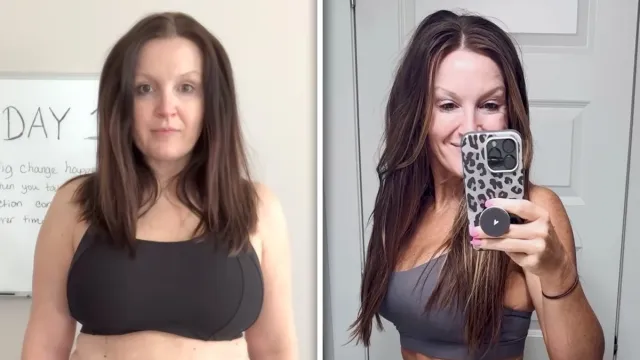Coach Lost 60 Pounds Doing These 4 "Unpopular" Things

There are lots of common weight loss methods – eating more protein, lifting weights, and cutting calories. However, one expert has some more unconventional tips. Kassie Magnusen is a weight loss and nutrition coach who helps "busy mamas drop fat & get the sculpted body they've always wanted," she writes in her Instagram bio. "4 unpopular things I do for fat loss that most people don't talk about," she captioned a post. "I might get some push back for some of these, but that's okay. This is what works for me."
She Avoids High-Intensity Cardio
Her first unpopular habit? "I avoid high-intensity cardio—it's never in my routine," she says. "Mostly because I just don't like it, and also because it's not the most effective for fat loss. I was a cardio bunny for years and I got burnt out on trying to 'burn more calories.' Now, I lift weights, walk daily (7-10k steps), and focus on building muscle. More muscle = higher metabolism = easier fat loss."
RELATED: I Got My Best Body After 50 and Here's How You Can, Too
She Eats First Thing in the Morning and Right Before Bed
Next, she eats first thing in the morning and right before bed. "No 'fasted cardio.' No 'cut off eating at 7 PM' rule. I fuel my body throughout the day to keep my metabolism running & prevent cravings. A balanced protein-rich meal before bed actually supports muscle recovery & better sleep," she writes.
She Doesn't Track Calories Burned in a Workout
She also doesn't keep track of how many calories she burns in a workout. "I used to stress over watching my fitness tracker & trying to 'burn more.' Now I just focus on getting stronger, not shrinking myself. Your workout isn't about calories burned and how much you sweat—it's about building muscle & changing your body composition," she says.
I Never Eat in a High-Calorie Deficit
The fourth thing she doesn't do? "I never eat in a high-calorie deficit," she says. "I don't do 1,200-calorie crash diets. I keep my deficit moderate so I can still eat enough to fuel workouts, keep my metabolism happy, and avoid bingeing."
Bottom Line: Fat Loss Isn't About Extremes
The bottom line? "Fat loss isn't about extremes. It's about eating enough, training smart, and building a body that burns more fat naturally," she said. And if you enjoyed this article, take advantage of these 15 Quick Ways to Lose Body Fat Percentage in a Week.




